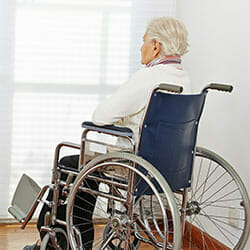
Does Nursing Home Understaffing Contribute to Abuse and Neglect?
- April 29
- Evans/Reilley
- Nursing Home Abuse
Families sometimes find that an elderly relative needs to be moved to a nursing home where 24-hour skilled care is available. But in recent years, many news stories have revealed that nursing homes aren’t necessarily the safest environment for residents.
Tales of nursing home employees’ abusing residents, neglecting their needs, and stealing from them have prompted some families to wonder how they can ensure their loved ones will be well cared for in a long-term care facility. To protect loved ones from potentially dangerous situations, families should visit several nursing homes and ask a lot of questions before choosing where to place a relative. One of the warning signs that a home could put residents at risk is understaffing.
The Effects of Understaffing
Texas law requires nursing homes to maintain appropriate staffing levels, but it does not mention specific caregiver-to-patient ratios. The National Citizens’ Coalition for Nursing Home Reform, however, says the minimally acceptable ratios should be:
- 1 direct caregiver to 5 residents (daytime)
- 1 direct caregiver to 10 residents (evening)
- 1 direct caregiver to 15 residents (night).
When nursing homes are understaffed, patients suffer. Some nursing homes may be understaffed simply because they can’t find enough qualified workers, but others choose to operate with the fewest employees possible, in order to save money. That’s a practice known as rationing – when staffing levels are so inadequate that workers can perform only the most basic functions of their job.
Some examples of rationing include:
- Using sedatives or restraints to keep patients in bed, or in their rooms, as a substitute for supervision
- Failing to properly document changes in a resident’s health, in order to save time
- Forcing residents to wear adult diapers rather than offering toileting assistance
- Inadequate supervision of nursing aides, due to supervisors being overworked
- Medication administration errors, due to working long shifts and/or being deprived of breaks.
When rationing is a business practice, residents are likely to be treated like burdens, rather than individuals. Overworked nurses and aides don’t have time to listen to residents’ questions or concerns, which means potentially life-threatening changes in a resident’s health may be overlooked. And when supervision is lax, unscrupulous workers may harm residents or steal from them.
Warning Signs
Families visiting nursing homes should be alert to signs that are commonly associated with understaffing, such as:
- Foul odors
- Dirty floors
- Ringing phones that no one answers
- Multiple illuminated nursing call lights
- Residents wearing soiled garments
- Administrative areas where papers or files are stacked high on surfaces
- Residents in wheelchairs “parked” in hallways, with no attendant present
- Disheveled workers and visibly agitated or exhausted workers.
Another sign of inadequate staffing is overcrowded public dining areas. Many nursing home residents need individual assistance when eating, and those patients are usually fed in their rooms. But in an understaffed facility, residents may be corralled into one dining area so staff can move more quickly among the patients that need assistance.
Best Practices
The Texas attorney general recommends that families call the state Department of Aging and Disability Services to request information about any nursing home they are considering for a relative. The DADS employees can answer questions about whether a nursing home has been cited for deficiencies or quality-of-care violations, has been the subject of formal complaints, or has had its license terminated in the past two years – and families may ask a nursing home to provide a copy of its most recent survey report, which would include any citations for health and safety violations.
If you have questions about how nursing home neglect might apply to your situation, discuss it with The Evans Law Firm. Call today at 1-855-414-1012 or fill out our online contact form to find out how we can help you.

 Serving Clients Throughout Texas
Serving Clients Throughout Texas
 Chip Evans is a partner at Evans & Herlihy. Chip brings to the firm more than 20 years of experience as a trial lawyer representing Plaintiffs. It is the desire to help individuals, not corporations, that attracts Chip to this side of the docket. [
Chip Evans is a partner at Evans & Herlihy. Chip brings to the firm more than 20 years of experience as a trial lawyer representing Plaintiffs. It is the desire to help individuals, not corporations, that attracts Chip to this side of the docket. [